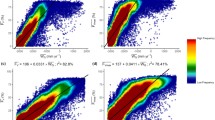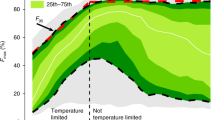Abstract
The sensitivity of evaporation to a prescribed vegetation annual cycle is examined globally in the Met Office Hadley Centre Unified Model (HadAM3) which incorporates the Met Office Surface Exchange Scheme (MOSES2) as the land surface scheme. A vegetation annual cycle for each plant functional type in each grid box is derived based on satellite estimates of Leaf Area Index (LAI) obtained from the nine-year International Satellite Land Surface Climatology Project II dataset. The prescribed model vegetation seasonality consists of annual cycles of a number of structural vegetation characteristics including LAI as well as canopy height, surface roughness, canopy water capacity, and canopy heat capacity, which themselves are based on empirical relationships with LAI. An annual cycle of surface albedo, which in the model is a function of soil albedo, surface soil moisture, and LAI, is also modelled and agrees reasonably with observed estimates of the surface albedo annual cycle. Two 25-year numerical experiments are completed and compared: the first with vegetation characteristics held at annual mean values, the second with prescribed realistic seasonally varying vegetation. Initial analysis uncovered an unrealistically weak relationship between evaporation and vegetation state that is primarily due to the insensitivity of evapotranspiration to LAI. This weak relationship is strengthened by the adjustment of two MOSES2 parameters that together improve the model’s LAI-surface conductance relationship by comparison with observed and theoretical estimates. The extinction coefficient for photosynthetically active radiation, k par , is adjusted downwards from 0.5 to 0.3, thereby enhancing the LAI-canopy conductance relationship. A canopy shading extinction coefficient, k sh , that controls what fraction of the soil surface beneath a canopy is directly exposed to the overlying atmosphere is increased from 0.5 to 1.0, which effectively reduces soil evaporation under a dense canopy. When the experiments are repeated with the adjusted parameters, the relationship between evaporation and vegetation state is strengthened and is more spatially consistent. At nearly all locations, the annual cycle of evaporation is enhanced in the seasonally varying vegetation experiment. Evaporation is stronger during the peak of the growing season and, in the tropics, reduced transpiration during the dry season when LAI is small leads to significantly lower total evaporation.















Similar content being viewed by others
References
Betts RA, Cox PM, Lee SE, Woodward FI (1997) Contrasting physiological and structural feedbacks in climate change simulations. Nature 387: 796–799
Bonan GB (1997) Effects of land use on the climate of the United States. Climatic Change 37: 449–486
Bonan G (2002) Ecological climatology: concepts and applications. Cambridge University Press, Cambridge, UK
Bounoua L, Collatz GJ, Los SO, Sellers PJ, Dazlich DA, Tucker CJ, Randall DA (2000) Sensitivity of climate to changes in NDVI. J Clim 13: 2277–2292
Buermann W, Dong J, Zeng X, Myneni RB, Dickinson RE (2001) Evaluation of the utility of satellite-based vegetation leaf area index data for climate simulations. J Clim 14: 3536–3550
Chase TN, Pielke RA, Kittel TGF, Nemani R, Running SW (1996) The sensitivity of a general circulation model to global changes in leaf area index. J Geophys Res 101: 7393–7408
Chase TN, Pielke RA, Kittel TGF, Nemani R, Running SW (2000) Simulated impacts of historical land cover changes on global climate in northern winter. Clim Dyn 16: 93–105
Choudhury BJ, DiGirolamo NE, Ssskind J, Darnell WL, Gupta SK, Asrar G (1998) A biophysical process-based estimate of global land surface evaporation using staellite and ancillary data II. Regional and global patterns of seasonal and annual variations. J Hydrol 205: 186–204
Cox PJ, Betts RA, Jones CD, Spall SA, Totterdell IJ (2000) Acceleration of global warming due to carbon-cycle feedbacks in a coupled climate model. Nature 408: 184–187
Cox PM (2001) Description of the “TRIFFID” dynamic global vegetation model. Technical Note 24. Hadley Centre, Meteorological Office, Bracknell, Berks, UK
Cox PM, Betts RA, Bunton CB, Essery RLH, Rowntree PR, Smith J (1999) The impact of new land surface physics on the GCM simulation of climate and climate sensitivity. Clim Dyn 15: 183–203
Cox PM, Huntingford C, Harding RJ (1998) A canopy conductance and photosynthesis model for use in a GCM land surface scheme. J Hydrol 212–213: 79–94
Hansen MC, DeFries RS, Townshend JRG, Sohlberg R (2000) Global land cover classification at 1 km spatial resolution using a classification tree approach. Int J Remote Sens 21: 1331–1364
Henderson-Sellers A, McGuffie K, Gross C (1995) Senstivity of global climate model simulations to increased stomatal resistance and CO2 increases. J Clim 8: 1738–1756
Herbst M, Kappen L, Thamm F, Vanselow R (1996) Simultaneous measurements of transpiration, soil evaporation and total evaporation in a maize field in northern Germany. J Experimental Bot 47: 1957–1962
Jarvis PG, James GB, Landsberg JJ (1975) Coniferous forest. In: Monteith JL (ed) Vegetation and the atmosphere. Academic Press, London, pp 171–240
Kelliher FM, Leuning R, Raupach MR, Schulze ED (1995) Maximum conductances for evaporation from global vegetation types. Agr Forest Meteorol 73: 1–16
Li Z, Garand L (1994) Estimation of surface albedo from space: a parametrization for global application. J Geophys Res 99: 8335–8350
Los SO, Collatz GJ, Malmstrom CM, Pollack NH, Fries RSD, Bounoua L, Parris MT, Tucker CJ, Dazlich DA (2000) A global 9-year biophysical land surface dataset from NOAA AVHRR data. J Hydrometeorol 1: 183–199
Lu L, Shuttleworth WJ (2002) Incorporating NDVI-derived LAI into the climate version of RAMSand its impact on regional climate. J Hydrometeorol 3: 347–362
Pielke RA, Avissar R, Raupach M, Dolman AJ, Zeng X, Denning AS (1998) Interactions between the atmosphere and terrestrial ecosystems: influence on weather and climate. Glob Change Biol 4: 461–475
Pope VD, Gallani ML, Rowntree PR, Stratton RA (2000) The impact of new physical parametrizations in the Hadley Centre climate model: HadAM3. Clim Dyn 16: 123–146
Ropelewski CF, Yarosh ES (1998) The observed mean annual cycle of moisture budgets over the central United States (1973–92). J Clim 11: 2180–2190
Schulze ED, Kelliher RM, Körner C, Lloyd J, Leuning R (1994) Relationships among maximum stomatal conductance, ecosystem surface conductance, carbon assimilation rate, and plant nitrogen nutrition. Annu Rev Ecol Syst 25: 629–660
Shukla J, Mintz Y (1982) Influence of land-surface evapotranspiration on the Earth’s climate. Science 215: 1498–1501
Sud YC, Fennessey M (1982) A study of the influence of surface albedo on July circulation in semi-arid regions using the CLAS GCM. J Climatol 2: 105–128
Sud YC, Shukla J, Mintz Y (1988) Influence of land-surface roughness on atmospheric circulation and precipitation: a sensitivity study with a general circulation model. J Appl Meteorol 2: 1036–1054
Acknowledgements.
This work was supported through the EU PROMISE project (EVK2-CT-1999–00022). The LAI data was provided as part of the ISLSCP II initiative through NASA Goddard DAAC [Hall FG, Meeson B, Los S, Steyaert L, Brown de Colstoun E, Landis D (eds) ISLSCP Initiative II. NASA. DVD/CD-ROM. NASA, 2003]. The surface albedo climatology was provided by the Canada Centre for Remote Sensing (http://www.ccrs.nrcan.gc.ca ). We thank Dr. P. Cox, Dr. R. Betts, Dr. C. Taylor and T. Osborne for valuable discussions regarding this work. The authors would also like to thank the anonymous reviewers for their constructive comments, which improved the quality of the work.
Author information
Authors and Affiliations
Corresponding author
Rights and permissions
About this article
Cite this article
Lawrence, D.M., Slingo, J.M. An annual cycle of vegetation in a GCM. Part I: implementation and impact on evaporation. Climate Dynamics 22, 87–105 (2004). https://doi.org/10.1007/s00382-003-0366-9
Received:
Accepted:
Published:
Issue Date:
DOI: https://doi.org/10.1007/s00382-003-0366-9




